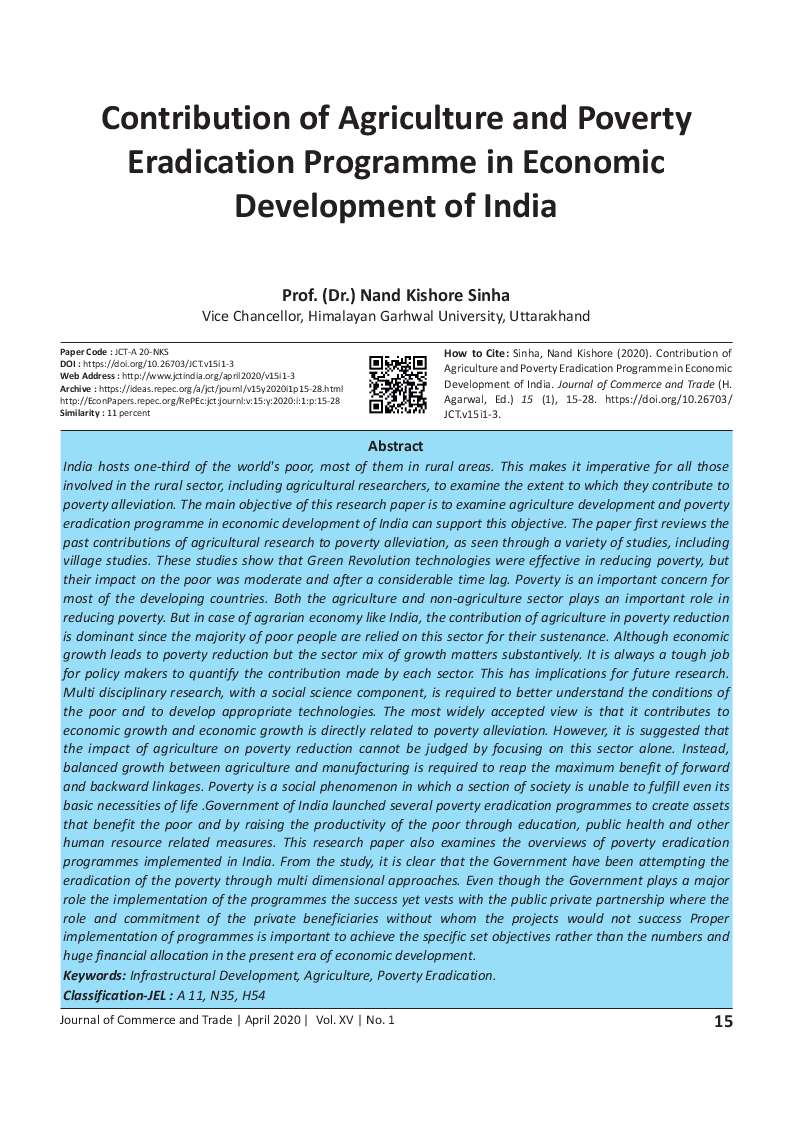Contribution of Agriculture and Poverty Eradication Programme in Economic Development of India
DOI:
https://doi.org/10.26703/jct.v15i1.45Keywords:
Infrastructural Development, Agriculture, Poverty EradicationAbstract
The paper first reviews the past contributions of agricultural research to poverty alleviation, as seen through a variety of studies, including village studies. These studies show that Green Revolution technologies were effective in reducing poverty, but their impact on the poor was moderate and after a considerable time lag. Poverty is an important concern for most of the developing countries. Both the agriculture and non-agriculture sector plays an important role in reducing poverty. But in case of agrarian economy like India, the contribution of agriculture in poverty reduction is dominant since the majority of poor people are relied on this sector for their sustenance. Although economic growth leads to poverty reduction but the sector mix of growth matters substantively. The most widely accepted view is that it contributes to economic growth and economic growth is directly related to poverty alleviation. Government of India launched several poverty eradication programmes to create assets that benefit the poor and by raising the productivity of the poor through education, public health and other human resource related measures. This research paper also examines the overviews of poverty eradication programmes implemented in India. From the study, it is clear that the Government have been attempting the eradication of the poverty through multi dimensional approaches. Even though the Government plays a major role the implementation of the programmes the success yet vests with the public private partnership where the role and commitment of the private beneficiaries without whom the projects would not success.
Downloads
References
Poverty Alleviation in Rural India-Strategy and Programmes, Chapter-3.2, 10th Five Year Plan, Planning Commission, Government of India, Vol-2, p.293
Agricultural and Processed Food Products Export Development Authority (APEDA), Department of Commerce and Industry, Union Budget 2018–19, Press Information Bureau, Ministry of Statistics and Programme Implementation, Press Releases, Media Reports, Ministry of Agriculture and Farmers Welfare, Crisil
Sharma, A. & Agarwal, H. (2018). Role of Government in eradication of Rural Poverty and Enhancing Employment in India. Contemporary Social Science(ISSN: 0302-9298), 27(3), 264-272.
Gaurav Datt and Ashwani Mahajan, Indian Economy, S. Chand & Company Ltd., New Delhi, 2011, p.370.
Dandekar, V. M. and N. Rath, Poverty in India, Dimensions and Trends, Economic and Political Weekly, January 2, 1971 and January 9, 1971
Report of the Expert Group on Estimation of Proportion and Number of Poor, Planning Commission, Government of India, 1993, p. 36.
Abhijit Sen, Estimates of Consumer Expenditure and its Distribution – Statistical Priorities after NSS 55th Round, Economic and Political Weekly, December 16, 2000.
Ministry of Planning Implementation( Central Statistical Office October, 2014), Govt. of India

Downloads
Published
Issue
Section
License
Copyright (c) 2020 Prof. (Dr.) Nand Kishore Sinha

This work is licensed under a Creative Commons Attribution 4.0 International License.










